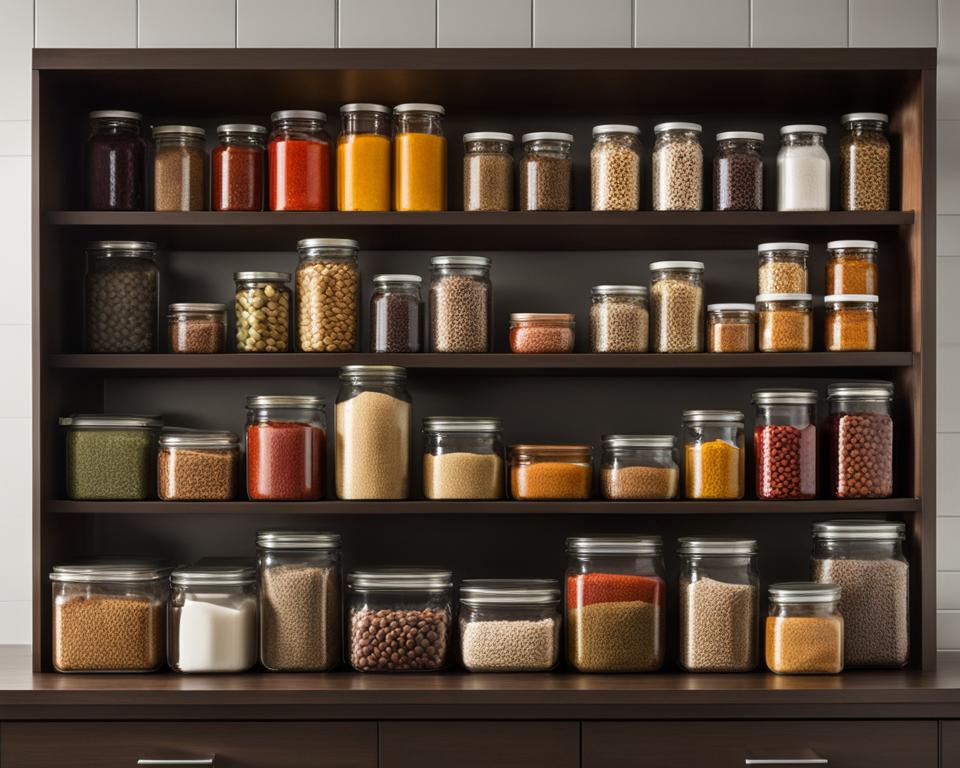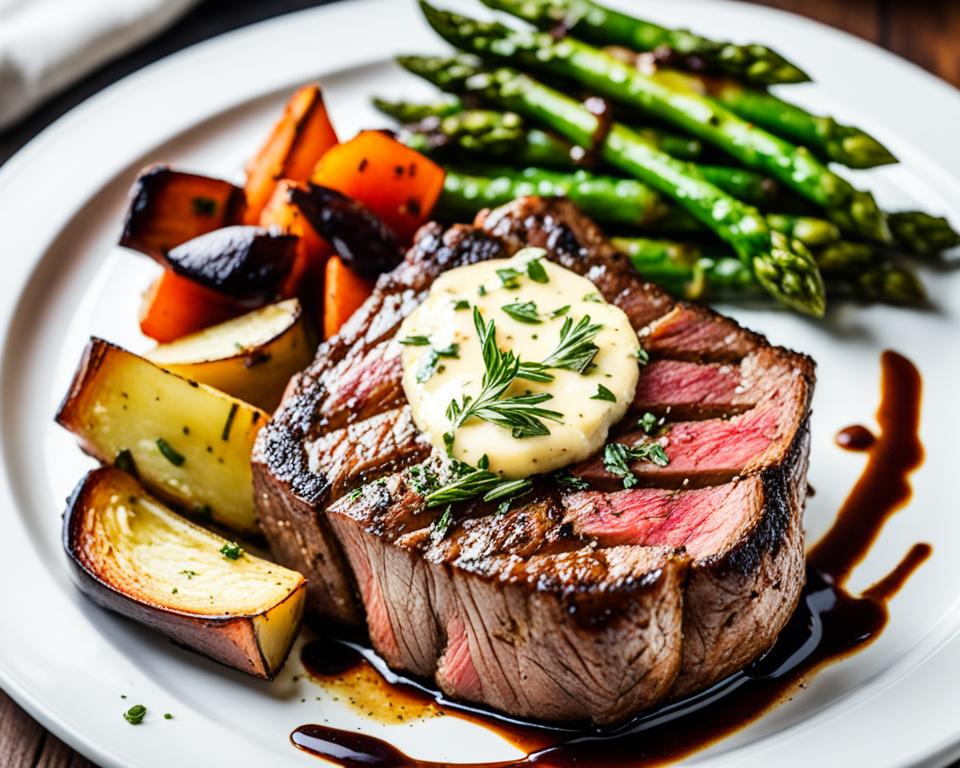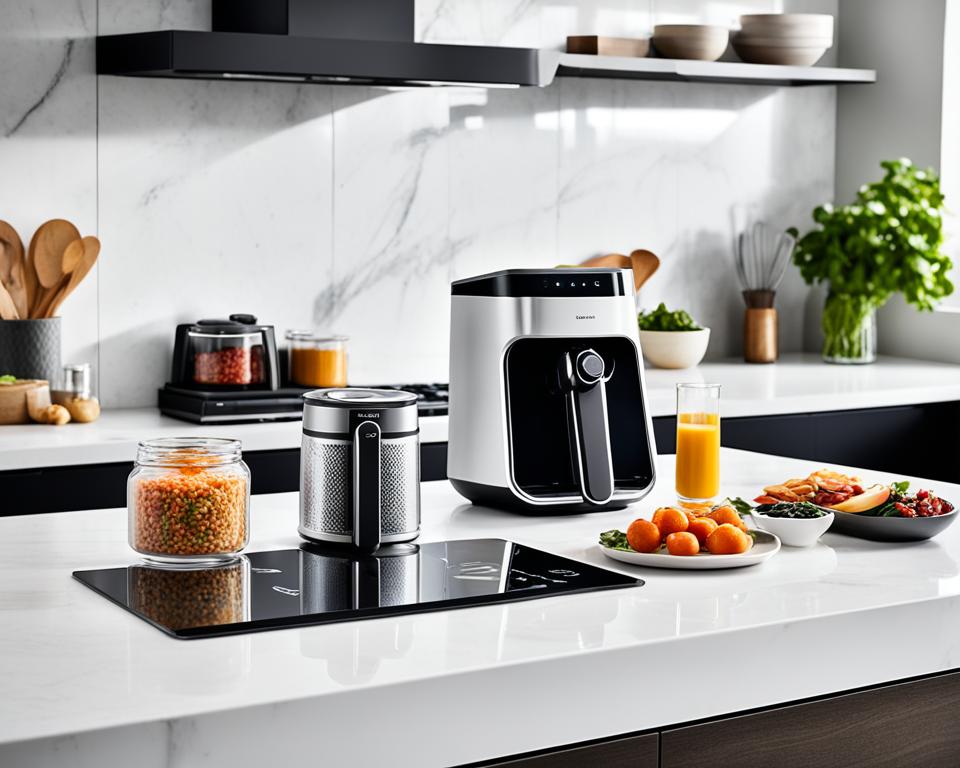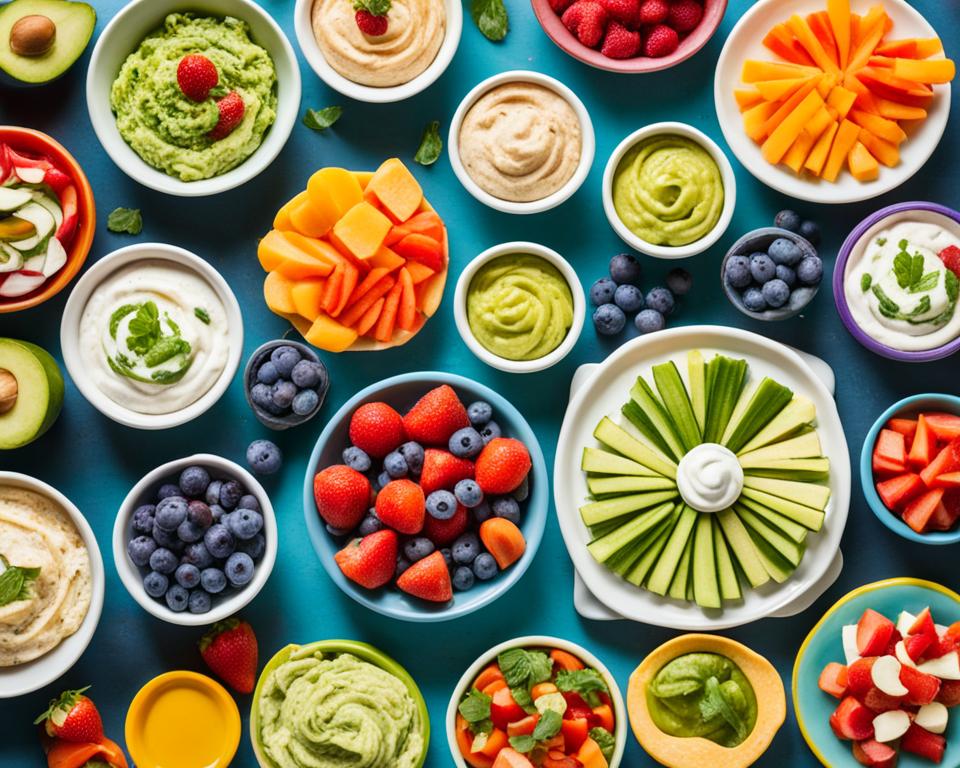To cook delicious and healthy meals on a budget, it’s important to have a well-stocked pantry with affordable and shelf-stable ingredients. These ingredients will not only save you money but also provide the foundation for a variety of meals. Let’s explore some of the essential and budget-friendly staples every budget cook should have in their kitchen.
Key Takeaways:
- Having a well-stocked pantry with affordable and shelf-stable ingredients is essential for budget cooking.
- In-season fresh fruits and vegetables can be budget-friendly and flavorful.
- Frozen fruits and vegetables are a cost-effective alternative to fresh produce.
- Beans are a versatile and affordable source of protein.
- Canned tomatoes are a must-have pantry staple for adding flavor to budget-friendly recipes.
In-season fresh fruits and vegetables
When it comes to budget-friendly produce, in-season fruits and vegetables are a game-changer. While they may be perceived as expensive, buying them when they are at their peak can actually save you money. Not only are they more affordable during their harvest season, but they also taste better. So why not indulge in the vibrant flavors of in-season produce while sticking to your budget?
When fruits and vegetables are in season, they are abundant and readily available, resulting in lower prices. This is because there is a higher supply, reducing the overall cost. Instead of paying a premium for out-of-season produce that has been transported long distances, opt for local and in-season options. You’ll be supporting local farmers and enjoying produce that is at its freshest and most flavorful.
Whether it’s juicy watermelon in the summer or crisp apples in the fall, in-season fruits offer a delightful burst of flavor that can elevate any dish. Similarly, in-season vegetables like ripe tomatoes, leafy greens, and crunchy bell peppers bring color, texture, and nutrients to your meals.
To help you make the most of your in-season produce, here are a few tips:
- Plan your meals around the fruits and vegetables that are currently in season.
- Visit your local farmers’ market for a wide variety of fresh and affordable produce.
- Consider joining a community-supported agriculture (CSA) program where you can receive a weekly box of seasonal produce directly from local farms.
- Buy in bulk and preserve the excess produce for later use, such as freezing berries or canning tomatoes.
- Experiment with different recipes and cooking methods to highlight the unique flavors of each in-season fruit and vegetable.
Remember, when you buy in-season, you not only save money but also support sustainable farming practices and enjoy the best that nature has to offer. So go ahead, embrace the flavors of the season and create budget-friendly meals that are both delicious and nutritious.
Frozen fruits and vegetables
Frozen fruits and vegetables are a cost-effective solution for incorporating nutritious produce into your meals, especially when fresh options are out of season.
Despite their frozen state, these fruits and vegetables maintain their nutritional value and can be used in a variety of delicious dishes. Incorporating frozen vegetables into stir-fries, soups, and casseroles adds color, flavor, and essential vitamins and minerals to your meals. Meanwhile, frozen fruits serve as a convenient addition to smoothies, desserts, and even savory recipes.
By opting for frozen fruits and vegetables, you not only save money but also reduce food waste since they have a longer shelf life compared to fresh produce. Stocking your freezer with a variety of options ensures you always have these cost-effective ingredients on hand when you need them.
Benefits of Frozen Fruits and Vegetables
- Cost-effective: Frozen fruits and vegetables are often more affordable than their fresh counterparts, making them a budget-friendly option for any home cook.
- Nutritious: Freezing fruits and vegetables preserves their vitamins and minerals, allowing you to reap the health benefits even when they are out of season.
- Convenient: Frozen produce is pre-cut and pre-washed, saving you time and effort in the kitchen.
- Versatile: You can use frozen fruits and vegetables in a wide range of recipes, from smoothies and salads to stews and bakes, adding flavor and nutrition to your meals.
Make the most of these cost-effective produce options by incorporating them into your favorite recipes. Experiment with different combinations, flavors, and cooking methods to discover new and exciting culinary creations.
| Aspect | Fresh Produce | Frozen Produce |
|---|---|---|
| Nutritional Value | May lose some nutrients over time | Nutrient content preserved due to quick freezing |
| Storage Lifespan | Short shelf life, requiring immediate consumption | Extended shelf life, allowing for better meal planning |
| Cost | Can be expensive, especially when out of season | More affordable, especially for off-season produce |
| Convenience | May require washing, peeling, and chopping | Pre-washed and pre-cut, reducing preparation time |
| Variety | Availability limited by seasonality | Wide variety available year-round |
Beans
Beans are a versatile and cost-effective source of protein that every budget cook should have in their pantry. Whether you prefer dried beans or canned beans, both options offer affordability and nutritional benefits.
Dried Beans
Dried beans are a budget-friendly staple that can be purchased in bulk and stored for a long time. They are a great option for those who prefer to cook from scratch and enjoy the process of soaking and simmering beans. From chickpeas to black beans, dried beans come in a variety of types, allowing you to add flavor and texture to your meals.
To cook dried beans, simply soak them in water overnight to soften the texture and reduce cooking time. After soaking, rinse the beans and then simmer them in a pot with fresh water until they are tender. Once cooked, you can portion the beans into freezer-friendly containers and freeze them for future use.
Canned Beans
If you prefer convenience and saving time in the kitchen, canned beans are an excellent option. They are precooked and ready to use, making them a convenient addition to a variety of dishes. Canned beans are an affordable and versatile ingredient that can be added to soups, salads, enchiladas, and rice dishes.
When using canned beans, be sure to drain and rinse them thoroughly to remove excess sodium and improve the taste. You can also add them to a colander and rinse them with cold water for a few minutes.
“Canned beans are a time-saving solution for busy cooks who still want to enjoy the benefits of incorporating beans into their meals.”
Whether you choose dried beans or canned beans, they offer an affordable way to incorporate protein into your meals. Beans are not only budget-friendly but also packed with essential nutrients such as fiber, vitamins, and minerals. Add beans to your favorite recipes to enhance their nutritional profile and enjoy a satisfying and affordable meal.
| Bean Variety | Cost (per pound) | Nutritional Benefits |
|---|---|---|
| Black Beans | $1.99 | High in fiber, protein, and iron |
| Chickpeas | $1.79 | Good source of protein, fiber, and folate |
| Kidney Beans | $1.79 | Rich in fiber, potassium, and antioxidants |
| Pinto Beans | $1.59 | Excellent source of fiber, protein, and magnesium |
Canned tomatoes
When it comes to budget-friendly pantry staples, canned tomatoes are an absolute must-have. Whether you prefer tomato paste, crushed tomatoes, or diced tomatoes, these preserved gems are versatile, convenient, and bursting with flavor. In our quest for affordable and delicious meals, canned tomatoes are a true game-changer.
One of the greatest advantages of using canned tomatoes is the time and money they save. Instead of spending hours simmering fresh tomatoes to make a homemade spaghetti sauce or chili, a can of tomatoes can offer the same rich flavor in a fraction of the time. With just a few ingredients, you can whip up a delicious tomato sauce or soup that will satisfy your taste buds and your wallet.
“Canned tomatoes are like a shortcut to the incredible taste of homemade dishes. With a can of tomatoes and some simple seasonings, you can create fantastic meals that will leave everyone wanting more.”
Tomato Varieties and Their Uses
Not all canned tomatoes are created equal, and understanding the different varieties will help you choose the right one for your recipes. Here are some common types of canned tomatoes and their best uses:
| Tomato Variety | Best Use |
|---|---|
| Tomato Paste | Thickening sauces and adding intense tomato flavor |
| Crushed Tomatoes | Making tomato sauce, chili, or lasagna |
| Diced Tomatoes | Adding to soups, stews, and casseroles for chunky texture |
Tips for Buying and Storing
When purchasing canned tomatoes, opt for brands that use high-quality tomatoes and minimal additives. Look for BPA-free cans for added peace of mind. It’s also helpful to buy in bulk when there are sales or discounts available.
To maximize the shelf life of your canned tomatoes, store them in a cool, dry place away from direct sunlight. Once opened, transfer any unused portion to an airtight container and refrigerate for up to 5 days. Remember to always check the expiration date before use.
With a stock of canned tomatoes in your pantry, you have the foundation for countless budget-friendly recipes. From classic marinara sauces to comforting soups and stews, these versatile ingredients will elevate your cooking and keep your wallet happy. So, why not give them a try and discover the endless possibilities that canned tomatoes bring to your kitchen?
Grains and Pasta
When it comes to budget-friendly carbohydrates, grains and pasta are essential pantry staples. Not only are they affordable, but they are also versatile and provide a satisfying base for a wide range of dishes. Whether you prefer rice, farro, quinoa, or dried pasta, these grains can be stored for long periods of time, making them convenient options for any budget cook.
Grains and pasta can be used to bulk up meals, such as soups and salads, adding substance and texture. They can also be combined with other ingredients to create diverse and budget-friendly dishes. Opting for whole wheat varieties is a great way to add nutritional value to your meals, as they are higher in fiber and contain more nutrients compared to refined grains.
Let’s explore some of the ways you can incorporate grains and pasta into your budget-friendly meals:
Create a grain or pasta-based salad
Combine cooked grains or pasta with fresh vegetables, protein sources like beans or grilled chicken, and a tangy dressing for a satisfying and budget-friendly salad. Not only does this make for a nutritious meal, but it also allows you to use up any leftovers you may have in your fridge.
Add grains or pasta to soups and stews
Grains and pasta are excellent additions to soups and stews, helping to thicken the broth and make the dish more filling. Whether you’re making a hearty vegetable soup or a comforting chicken noodle soup, the addition of grains or pasta adds substance and makes the meal more satisfying.
Create flavorful grain bowls
Grain bowls have gained popularity in recent years, and for good reason. They are not only delicious but also a great way to use grains as a base for a well-rounded meal. Start with a grain of your choice, such as quinoa or rice, then top it with protein, vegetables, and a flavorful sauce. The possibilities are endless, allowing you to get creative with your ingredients while sticking to your budget.
“Grains and pasta are affordable and versatile ingredients that can be stored for long periods of time. They can be used to bulk up meals, such as soups and salads, and provide a satisfying base for various dishes.”
So, whether you’re on a tight budget or simply looking for cost-effective meal options, grains and pasta are your go-to ingredients. With their affordability, versatility, and ability to create filling and delicious meals, they are a budget cook’s best friend. Stock your pantry with a variety of grains and pasta options, and let your creativity in the kitchen take flight.
Potatoes
When it comes to affordable vegetables, potatoes often take the spotlight. These versatile tubers are not only a budget-friendly option but also a nutritious addition to your meals. Whether you prefer them baked, roasted, or added to soups, potatoes can be the star ingredient that brings flavor and substance to your dishes.
One of the greatest advantages of potatoes is their affordability. They are available year-round and are generally more inexpensive compared to other vegetables. With potatoes on hand, you can create satisfying meals without breaking the bank.
So Many Options
The versatility of potatoes is truly remarkable. From creamy mashed potatoes to crispy roasted wedges, the possibilities are endless. You can use them as a side dish, incorporate them into casseroles, or even turn them into hearty main courses.
Here are just a few ideas to inspire you:
- Classic baked potatoes topped with sour cream, chives, and melted cheese.
- Golden French fries seasoned with your favorite spices.
- Scalloped potatoes layered with cheese and baked to creamy perfection.
- Potato and leek soup for a comforting and hearty meal.
- Hash browns served with eggs and bacon for a delicious breakfast.
Storage Tips
To make the most of your potatoes and ensure they stay fresh for longer, it’s essential to store them properly. Keep them in a cool, dry, and dark place, such as a pantry or cellar. Avoid storing them near onions, as this can cause both vegetables to spoil faster.
Additionally, it’s important to inspect your potatoes regularly and remove any that are sprouting or have gone bad. By doing so, you can prevent the spoilage from spreading to the rest of the batch. Remember, a little extra care goes a long way in maximizing the shelf-life of this affordable pantry staple.

Don’t underestimate the power of potatoes in your kitchen. Not only are they an affordable and versatile ingredient, but they also add a comforting touch to your meals. Experiment with different cooking methods and recipes, and discover the countless ways you can enjoy this humble yet mighty vegetable.
Conclusion
Cooking on a budget doesn’t mean compromising on taste or nutrition. By utilizing affordable and shelf-stable ingredients like in-season produce, frozen fruits and vegetables, beans, canned tomatoes, grains, pasta, potatoes, and proteins such as eggs, canned tuna, rotisserie chicken, and tofu, you can whip up delicious and cost-effective meals without breaking the bank.
With a well-stocked pantry, you have the foundation to create a wide variety of dishes while keeping your expenses under control. By taking advantage of sales on in-season fruits and vegetables, incorporating frozen produce, and making use of versatile staples like beans, canned tomatoes, and grains, you’ll be able to stretch your meals and save money in the process.
So, don’t let a tight budget hold you back from enjoying satisfying and flavorful meals. With the right ingredients and some creativity, you can master the art of budget cooking, discovering new and affordable ways to create cost-effective meals that are both nourishing and delicious. Happy cooking!
FAQ
What are some inexpensive, shelf-stable ingredients every budget cook should have?
To cook delicious and healthy meals on a budget, it’s important to have a well-stocked pantry with affordable and shelf-stable ingredients. These ingredients will not only save you money but also provide the foundation for a variety of meals. Let’s explore some of the essential and budget-friendly staples every budget cook should have in their kitchen.
How can I save money on fresh fruits and vegetables?
In-season fresh fruits and vegetables are often considered expensive, but buying them when they are at their peak can actually save you money. Not only are they more affordable during their harvest season, but they also taste better. Look for fruits and vegetables that are in season, and enjoy their delicious flavors while sticking to your budget. Additionally, make sure to use up the produce before it goes bad by following proper storage tips.
What are some budget-friendly alternatives to fresh produce?
Frozen fruits and vegetables are a great alternative to fresh produce, especially when they are out of season. They are just as nutritious and can be used in a variety of dishes. Whether you’re adding frozen vegetables to stir-fries or using frozen fruits in smoothies, these budget-friendly options will help you stretch your meals and save money. Keep a stock of frozen fruits and vegetables in your freezer to always have them on hand.
How can beans be a budget-friendly ingredient?
Beans are a versatile and cost-effective source of protein. Dried beans are inexpensive and can be cooked in bulk, portioned, and frozen for future meals. Canned beans are a convenient option that can be easily added to various dishes. Use beans to bulk up enchiladas, salads, soups, and rice, and enjoy their nutritional benefits without breaking the bank.
Why are canned tomatoes a pantry staple for budget cooking?
Canned tomatoes, whether in the form of paste, crushed, or diced, are a must-have ingredient in any budget cook’s pantry. They can be used to quickly and easily make spaghetti sauce, chili, or soup. Buying tomatoes in a preserved form saves you time and money while adding flavor to your dishes. Keep a stock of canned tomatoes to enhance the taste of your budget-friendly recipes.
What are some budget-friendly grains and pasta options?
Grains such as rice, farro, quinoa, and dried pasta are affordable and versatile ingredients that can be stored for long periods of time. They can be used to bulk up meals, such as soups and salads, and provide a satisfying base for various dishes. Opt for whole wheat varieties for added nutritional value. With a wide range of grain and pasta options, you can create diverse and budget-friendly meals.
How can potatoes be a budget-friendly and versatile ingredient?
Potatoes are often overlooked as a budget-friendly and nutritious vegetable. They are inexpensive and can be stored for a long time when stored properly. Whether baked, roasted, or added to soups, potatoes can be a versatile addition to your meals. Don’t underestimate the potential of this affordable pantry staple.
How can I cook delicious and cost-effective meals on a budget?
Cooking on a budget doesn’t mean sacrificing flavor or nutrition. By stocking up on inexpensive and shelf-stable ingredients like in-season produce, frozen fruits and vegetables, beans, canned tomatoes, grains, pasta, potatoes, as well as eggs, canned tuna, rotisserie chicken, and tofu, you can create delicious and cost-effective meals. With a well-stocked pantry, you’ll have the foundation to stretch your meals and save money while still enjoying a variety of recipes. Happy budget cooking!





